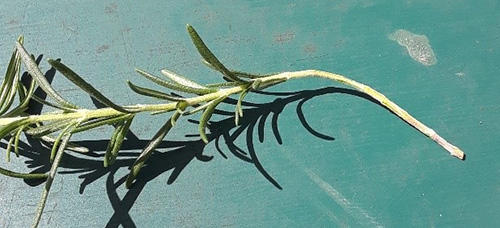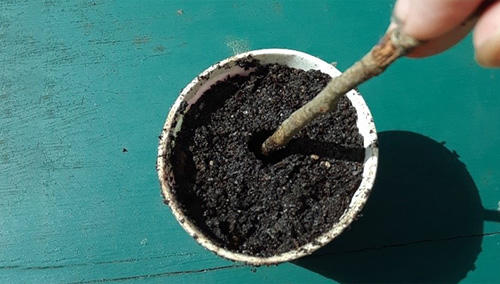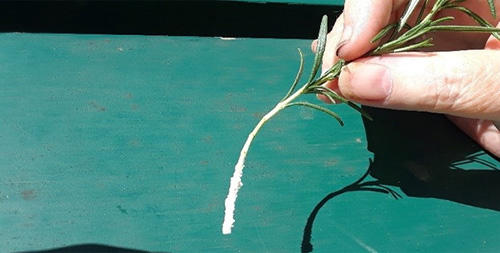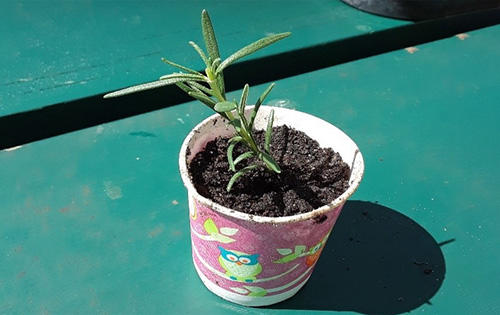A useful skill is the ability to propagate plants from cuttings, particularly if the seeds are scarce. Mastering is an easy task and it only takes time and a bit of attention to grow a whole new generation of plants for your garden. If you’ve never tried cuttings to replicate plants, learn the skill now. You might need it someday.
Plant reproduction by cuttings has advantages, as well. Seeds don’t always produce a plant as prolific as their parent, particularly in the case of hybrids. We know how to grow heirloom plants, since hybrid plant seeds of the second generation are not effective and most often do not produce a strong plant. But, when you grow a plant from a cutting process, it’s going to be genetically identical with the parent plant. Cutting propagation often saves you the time required for the formation and germination of seeds. In many cases, the cuttings mature faster than seedlings and produce fruit sooner.
Another advantage is the ability to further prolong your garden before fall. Mid-summer, taking cuttings to produce new plants when your plants are healthy. A couple of weeks later, as the original plants die from the heat, you’ll have new plants to replace them and continue to produce.
Choosing the Mother Plant
The most important step in the whole process is probably the selection of the mother plant. The mother will be genetically identical to your new plants, so choose the best plant possible. You want a healthy plant that grows well and does perform well. For instance, if you have one tomato plant which out-produces all the others, that is the plant to choose from, as long as it is still healthy. If you choose a sick plant that only gives you one tomato, don’t expect the cuttings to do any better than that. If your plant is contaminated you could even spread disease.
Ideally, opt for new growth from a strong, growing plant. If there are flowers or fruits, remove them. You want to put energy into growing roots through your cutting, not producing fruit. That’s why, I also avoid fertilizing the plant until I take my cuttings and I don’t fertilize the fresh cutting until it’s done well. Too much nitrogen will concentrate cutting on growing more leaves and missing the roots. If the nutrients are momentarily short, roots may expand in an effort to acquire them.
One warning: Patents protect certain hybrid plants and it is illegal to spread them by cuttings. Before taking cuttings, ensure you have the right to do so, particularly if the mother plant is a new patentable hybrid variety.
The Rooting Medium
Your rooting medium will be poor in fertility and sterile. It will keep water well, but be sufficiently well-drained to aerate. Many gardeners use a single-part peat mixture and one-part perlite or sand mix. I prefer to use straight sand because it holds good moisture and has sufficient structure to support the plant. You don’t want a soggy beach, just a warm air.
Four Types of Cuttings
There are four different plant forms that can be cuttings to reproduce: herbaceous, softwood, semi-hardwood, and hardwood. There are multiple ways to reproduce each, but I will teach you the way I learned many years ago in the Horticulture class. For most plants this is effective.
Related: This Common Driveway Weed is One of Nature’s Most Powerful Survival Plants
Herbaceous and Semi-Hardwood Plants
Herbaceous and semi-hardwood plants comprise a long list of flora and vegetables. You probably have noticed I mention fruits and vegetables, not ornamentals. My gardening has always focused on edible plants, but many ornamental plants do work with these methods, so don’t let my predisposition deter you. Here are some of the plants which may be propagated using the process of herbaceous plant cutting.
- Basil
- Bok Choy (use root end)
- Curry
- Lavender
- Lemon balm
- Lemon Verbena
- Marjoram
- Mints
- Oregano
- Parsley
- Peppers
- Rosemary
- Sage
- Salvia
- Savory
- Stevia
- Tarragon
- Thyme
- Tomatoes
- True Hyssop
- Watercress
Stem and Branch Cutting from Herbaceous Plants and Soft-Wood Plants
Herbaceous plants are plants which are nonwood. Those are, in my opinion, the easiest and fastest to root. Soft wood cuttings can also be easily rooted and well performed. I’m going to list some plants I’ve rooted in this way or I know how to work well. However, unlisted plants may well grow equally well. Giving it a try doesn’t take much effort.
Rooting Herbaceous and Soft-Wood Plants
1. Stem cuttings or cuttings from trees are the simplest cuttings to spread. When the plant is new and completely turgid, I recommend taking the cuttings in the morning. To cut a stem off at the stalk or just below new leaves, use a sharp knife or pruning shears. You can root a piece as small as 2-inch or less but I tend to use pieces of 4 to 6-inch. Terminal stalks are best, however, multiple pieces can be cut into a long stem.
2. Remove the leaves up to half the stem from the bottom third. Place the stem in water or cover it in towels of wet paper and place in a plastic bag. Keep the cuttings cold until they are ready to use.

3. Fill a small cup of paper or other container with moist sand or medium for rooting. Use a thin stick or pencil to make a hole in the middle of the sand.

4. Put a small amount of rooting hormone on a sheet of paper or other shallow container. Roll the bare end into the rooting hormone when cutting. The rooting hormone will stick to the end if the stem is moist (it should be).

5. In your rooting medium, stick the hormone-coated end into the hole and push around the cut to protect it. If you try to stick the cutting into the medium without first making the hole, it will scrap the rooting hormone off during the process.
Note: Rooting hormone is not necessary, but it makes the rooting go faster and increases your chances of success. Use it if you can.

6. Maintain the moist sand or rooting medium and in a humid environment. The best way to do that is to use plastic to cover the rooting. Half of a water bottle or soda bottle turned over the cut and stem works well.Gardeners all have their own methods, but I like putting the potted cuttings with a clear dome lid into a large take-out bowl. Keep the cuttings from direct sunlight.
7. Test every day for the amount of moisture. You want the sand to be moist, but not soggy. Give the stem a slight tug after two to three weeks or when the plant seems to thrive. Unless it rises from the hole, it is not embedded. But, if the roots keep the plant in the ground, it can be transplanted into a larger pot or into the garden.
Semi-Hardwood and Hardwood Cuttings
Plants containing semi-hardwood and hardwood include bushes and trees. Many of these are usually propagated by grafting the plant onto a rootstock which is specially grown. This method produces a strong plant and is used to make plants and trees in the nursery. When we take a cutting stem and root it using the method below, we’ll grow the cutting’s natural roots. The roots may not be as strong as the plant that was originally grafted, but the plant may take root and grow.
When using hardwood and semi-hardwood cuttings start with more cuttings than you need. The cuttings are harder to root and will not survive on all plants.
Related: 10 Medical Home Emergencies and How to Treat Them
Plants to Root Using the Woody Plants Method
- Blackberries
- Blueberries
- Currants
- Elderberry
- Fig
- Gooseberries
- Grapes
- Honeyberry
- Kiwi
- Lemon tree and other citrus (normally grafted)
- Mulberry
- Olive
- Orange tree (normally grafted onto sour orange rootstock)
- Plums (success varies with variety)
- Pomegranate
- Raspberries
How to Root Semi-Hardwood and Hardwood Cuttings
For woody plants, after the plant has gone dormant take the cutting in fall. A bigger piece is needed around 6 to 12 inches. Follow these basic steps:
1. Take a good cut from a soft branch with at least 2 notes (the swollen bump where the leaves are connected to the stem) in it. You want a branch with a diameter of about 1⁄4 to 3/8 inches in diameter.
2. If there are leaves present, remove all but a few of the topmost leaves.
3. Coat with rooting hormone the smallest inch or two of the cutting. Place the cut into moist garden soil or potting soil. One of the nodes should be below ground and one above ground.
4. Keep the soil moist and the cutting warm. The cutting is usually placed in a plastic bag and secured with a twist tie or rubber band. Check the daily moisture level. Water the soil to keep it moist, as needed, but not soggy.
5. When the cuttings begin to grow from the top, transplant the cutting into the garden or a large pot.
Trench Method of Propagation for Hardwood Cuttings
If your climate and soil are favorable, you can root hardwood cuttings in a trench to be transplanted the next year. Here is the method:
1. Take cuttings of 6 to 12 inches, as mentioned above. Make a trench by pushing and rocking a shovel into the soil to form a narrow slit trench. If the soil is clay, amend it with coarse sand to improve the drainage.
2. Place the cuttings in the trench so that only one third of the cutting is above ground and at least two inches apart from the cuttings. Press the soil down around the cuttings.
3. Water the soil around the cuttings. Over the winter, it should stay damp. Periodically check the soil and water again, if necessary. (which will depend on the weather.)
4. In the spring, at the top of the cuttings will appear new growth. Carefully dig up the cuttings and move to their final location.
Related: Having Debilitating Migraines? Read This!
Other Types of Cuttings
While I’ve concentrated on stem and branch cuttings here, a lot of other types of cuttings can develop. Most plants will grow from root cuttings and some will even grow from a section of a leaf a whole new plant. Trying to root whatever sort of cutting you’ve got never hurts. My pineapple garden grows from the ripe pineapple tops cut off from it.
Most plants do not even need to grow by a rooting medium. In my pictures, I put my rosemary stems in garden soil, but a lot of gardeners root their rosemary in water alone. tI prefer soil, because it is easier to transplant later. (I actually prefer sand, but when I potted the rosemary, I didn’t have any).
Vegetables Grown from Root Cuttings
Much of the root vegetables can be grown from a root piece. Ginger is a prime example. By seeding a small knob of store-bought ginger or turmeric, you can grow a large pot of ginger. Every spring I plant a knob and harvest enough ginger to last me through the year. Whenever I need ginger, I simply dig a piece up.
The following vegetables can be grown from a root cutting. Potatoes and sweet potato root cuttings should include an eye.
- Horseradish
- Jerusalem artichokes
- ginger
- Potatoes
- Sweet potatoes
- Turmeric
Many leafy type vegetables can be easily regrown from the original plant’s root end, even if the roots are cut off. The roots often don’t re-grow, but the leafy vegetables do. These may be harvested over and over. Such work best in flowing water or wet sand:
- Beet greens
- Bok choy
- Cabbage
- Carrots
- Celery
- Fennel
- Leeks
- Lemon grass
- Lettuces
- Onions
- Rutabaga
- Scallions
Strawberry cuttings are easily removed from cuttings taken from runners when the roots start to develop.
There are probably other vegetables that I do not know about can be rooted in this way. Experience the process and see what you can learn. In my neighborhood, there is a lady who has a huge garden which grows only from rooted cuttings and discarded seeds. Not only does she grow all her own vegetables, but with those vegetables, she feeds a lot of the neighborhood. The method is that powerful.











